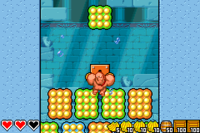Switch Peg: Difference between revisions
From the Super Mario Wiki, the Mario encyclopedia
Jump to navigationJump to search
No edit summary |
|||
| Line 1: | Line 1: | ||
[[File:DKKOSDKUnderwaterRuins.png|thumb|[[Donkey Kong]] pulling on a Switch Peg to reveal a Peg Board in the level [[Underwater Ruins]]]] | [[File:DKKOSDKUnderwaterRuins.png|thumb|[[Donkey Kong]] pulling on a Switch Peg to reveal a Peg Board in the level [[Underwater Ruins]]]] | ||
'''Switch Pegs'''<ref>''DK: King of Swing'' instruction booklet | '''Switch Pegs'''<ref name=dkkos>{{cite|title=''DK: King of Swing'' instruction booklet|page=15|date=2005|author=Nintendo|publisher=Nintendo of America|language=en-us}}</ref> are variants of [[peg]]s appearing in ''[[DK: King of Swing]]''. They appear as a lever with two pegs for handles attached to either a red, green, or blue box. If held onto with both hands, the lever is pulled down, revealing additional [[Peg Board]]s or pegs to help Donkey Kong progress through the level. Donkey Kong is able to pull the lever down if the player presses and holds both {{button|gba|L}} and {{button|gba|R}} while he is on the Switch Peg. They first appear in the level [[Contraption Cave]] in the [[Jungle World]]. | ||
Switch pegs, also referred to as '''Switch Handles''',<ref>''Donkey Kong: Jungle Climber'' | Switch pegs, also referred to as '''Switch Handles''',<ref>{{cite|title=''Donkey Kong: Jungle Climber'' instruction booklet|page=14|date=2007|publisher=Nintendo of America|author=Nintendo|language=en-us}}</ref> return in ''[[DK: Jungle Climber]]'', where they function exactly the same. They first appear in the level [[Glass Labyrinth]] in [[Lost Island]]. | ||
== | ==Profiles== | ||
'''''DK: King of Swing'' instruction booklet''' | *'''''DK: King of Swing'' instruction booklet:''' ''Grab with both hands to lower the lever and operate the mechanism.''<ref name=dkkos/> | ||
*'''''DK: Jungle Climber'' in-game tutorial:''' "''The {{color|Glass Labyrinth|red}} sure is a strange place, fanana. You have to pay CLOSE attention, or it's easy to get tricked, fanana! You need to use the {{color|switch pegs|red}} above to keep going, fanana. {{color|Grab|red}} the {{color|switch pegs|red}} with both hands or they won't work work bo bork!''" - [[Xananab]] | |||
'''''DK: Jungle Climber'' in-game tutorial''' | |||
==Names in other languages== | ==Names in other languages== | ||
{{foreign names | {{foreign names | ||
|Jap=スイッチトッテ<ref>'' | |Jap=スイッチトッテ<ref>{{cite|title=ドンキーコング ジャングルクライマー (''Donkī Kongu Janguru Kuraimā'') instruction booklet|page=19|date=2007|publisher=Nintendo|author=Nintendo|language=ja}}</ref> | ||
|JapR=Suitchi Totte | |JapR=Suitchi Totte | ||
|JapM=Switch Grip | |JapM=Switch Grip | ||
|Ita=Appiglio a barra<ref> | |Ita=Appiglio a barra<ref>{{cite|url=www.mariocastle.it/risorse/manuali/dk-king-of-swing/6.jpg|title=''DK: King of Swing'' instruction booklet|page=113|publisher=Nintendo of Europe|date=2005|author=Nintendo|language=it}}</ref> | ||
|ItaM=Plank handhold | |ItaM=Plank handhold | ||
}} | }} | ||
Revision as of 09:45, May 31, 2024
Switch Pegs[1] are variants of pegs appearing in DK: King of Swing. They appear as a lever with two pegs for handles attached to either a red, green, or blue box. If held onto with both hands, the lever is pulled down, revealing additional Peg Boards or pegs to help Donkey Kong progress through the level. Donkey Kong is able to pull the lever down if the player presses and holds both ![]() and
and ![]() while he is on the Switch Peg. They first appear in the level Contraption Cave in the Jungle World.
while he is on the Switch Peg. They first appear in the level Contraption Cave in the Jungle World.
Switch pegs, also referred to as Switch Handles,[2] return in DK: Jungle Climber, where they function exactly the same. They first appear in the level Glass Labyrinth in Lost Island.
Profiles
- DK: King of Swing instruction booklet: Grab with both hands to lower the lever and operate the mechanism.[1]
- DK: Jungle Climber in-game tutorial: "The red sure is a strange place, fanana. You have to pay CLOSE attention, or it's easy to get tricked, fanana! You need to use the red above to keep going, fanana. red the red with both hands or they won't work work bo bork!" - Xananab
Names in other languages
| Language | Name | Meaning | Notes |
|---|---|---|---|
| Japanese | スイッチトッテ[3] Suitchi Totte |
Switch Grip | |
| Italian | Appiglio a barra[4] | Plank handhold |
References
- ^ a b Nintendo (2005). DK: King of Swing instruction booklet. Nintendo of America (American English). Page 15.
- ^ Nintendo (2007). Donkey Kong: Jungle Climber instruction booklet. Nintendo of America (American English). Page 14.
- ^ Nintendo (2007). ドンキーコング ジャングルクライマー (Donkī Kongu Janguru Kuraimā) instruction booklet. Nintendo (Japanese). Page 19.
- ^ Nintendo (2005). DK: King of Swing instruction booklet. Nintendo of Europe (Italian). Page 113.
| DK: Jungle Climber | ||
|---|---|---|
| Characters | Playable | Donkey Kong • Diddy Kong • Dixie Kong • Funky Kong |
| Non-playable | Candy Kong • Cranky Kong • Wrinkly Kong • Xananab | |
| Enemies and obstacles | Bramble • Click-Clack • Flipflap • Flitter • Ghost • Klobber • Kritter • Lockjaw • Mini-Necky • Neek • Puftup • Shuri • Spike • Zinger | |
| Bosses | Banana Ship • Junklomp • Mega Amp • Draglinger • King K. Rool | |
| Items | Banana • Banana Bunch • Banana Coin • Crystal Banana • Crystal Star • DK Coin • Gem • Hammer • KONG Panels • Oil barrel • Torch • Wings | |
| Objects | Booster Barrel • Cannon Barrel • DK Barrel • Exit • Giant flower • Handle Peg • Iron Barrel • Jack Peg • Mine • Peg • Peg Board • Question Barrel • Rock • Spike • Spirowarp • Spinner Barrel • Spinning Peg • Switch Peg • TNT Barrel | |
| Worlds | Sun Sun Island • Lost Island • Ghost Island • Chill 'n' Char Island • High-High Island • Wormhole • Extra Stages | |
| Minigames | Rolling Panic • Banana Grab • Speed Climb • Throw 'n' Crush • Orange Picker • Booster Battle • Banana Bonanza | |
